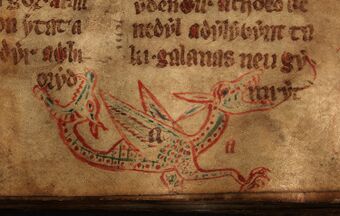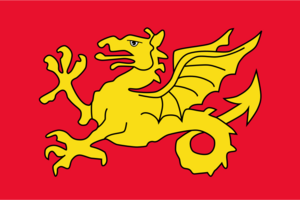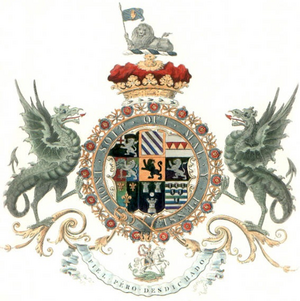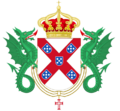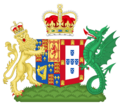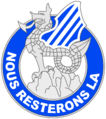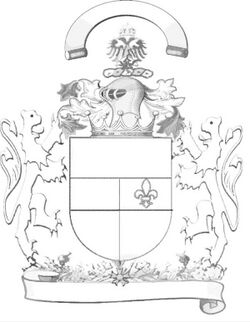Wyvern
Topic: Unsolved
 From HandWiki - Reading time: 7 min
From HandWiki - Reading time: 7 min
A wyvern (/ˈwaɪvərn/ WY-vərn, sometimes spelled wivern) is a legendary creature with a dragon's head and wings, a reptilian body, two legs, and a tail often ending in a diamond- or arrow-shaped tip. A sea-dwelling variant dubbed the sea-wyvern has a fish tail in place of a barbed dragon's tail.
The wyvern in its various forms is important to heraldry, frequently appearing as a mascot of schools and athletic teams (chiefly in the United States, United Kingdom, and Canada). It is a popular creature in European and British literature, video games, and modern fantasy. The wyvern in heraldry and folklore is rarely fire-breathing like the four-legged dragon. Sometimes modern fantasy book and media authors have wyverns that are frost-breathing or poison-breathing instead of fire-breathing.
Etymology
The current spelling wyvern is not attested before the seventeenth century as "winged two-footed dragon".[1] According to the Oxford English Dictionary, it is an alteration of Middle English wyver (attested thirteenth century), from Anglo-French wivre (cf. French guivre and vouivre), which originate from Latin vīpera, meaning "viper", "adder", or "asp".[1][2] Conversely, medievalist William Sayers proposes a more complex origin for the term. He notes that the Anglo-French guivre and its Middle English derivative ceased to retain the original sense of "venomous snake" after the Latin term was re-introduced into medieval Latin, freeing them up to take an alternate meaning[3]:460 Adducing another meaning of wiver (this time Old English) and guivre, "light javelin",[3]:461 and noting partial resemblences between the size and shape of javelins and snakes,[3]:462 plus the later medieval era's increasing use of heavy armor and decreasing use of light javelins, he proposes that the concepts of "venomous snake" and "light javelin" were melded to produce a new term for a previously unimagined concept of flying snake, a kind of dragon.[3]:463
History
The design of the wyvern is thought[by whom?] to have derived from the figure of the dragon encountered by Trajan's legions in Dacia. It may be the origin of the red dragon of Wales and the golden dragon of the Kingdom of Wessex carried at the Battle of Burford in AD 752.[4]
The concept of winged snakes is common in cultures around the Mediterranean, with a notable example being the Egyptian goddess Wadjet.[5] The oldest creatures outright referred to as "winged dragons" are Helios' chariot steeds, which aid Medea.
Distinction from dragons
Wyverns are very similar to dragons, and in many languages, cultures and contexts no clear distinction is made between the two. Since the sixteenth century, in English, Scottish, and Irish heraldry, the key difference has been that a wyvern has two legs, whereas a dragon has four. However, this distinction is not commonly observed in the heraldry of other European countries, where two-legged dragon like creatures being called dragons is entirely acceptable.[6]
In modern fiction
In the modern fantasy genre, there is little differentiation between dragons and wyverns, with two-legged, magical reptilian creatures all likely to be referred to as "dragons" without any differentiation between types. Wyverns, when present as creatures distinct from dragons, tend to appear as less magical and more as dangerous beasts smaller, weaker, and less intelligent than dragons. While a fantasy dragon often has a breath weapon, such as fire, wyverns rarely have such abilities and are more feared for their ferocity and sharp teeth and claws. Wyverns are sometimes associated with poison, either in the form of venomous fangs or poisonous breath, but this trait is not universally represented and may be a more recent addition to the lore based on the gila monster. A wyvern will typically be unable to speak, while a dragon often does have that ability.[citation needed]
The wyvern features frequently in modern fantasy fiction, though its first literary appearances may have been in medieval bestiaries.[7]
In heraldry
The wyvern is a frequent charge in English heraldry and vexillology, also occasionally appearing as a supporter or crest.
A white (Argent) wyvern formed the crest of the Borough of Leicester as recorded at the heraldic visitation of Leicestershire in 1619: "A wyvern sans legs argent strewed with wounds gules, wings expanded ermine." The term "sans legs" may not imply that the wyvern was "without legs", rather that its legs are not depicted, being hidden or folded under.[8][9][10] This was adopted by the Midland Railway in 1845, when it became the crest of its unofficial coat of arms.[11] The company asserted that the "wyvern was the standard of the Kingdom of Mercia", and that it was "a quartering in the town arms of Leicester".[12][13][14][15] However, in 1897 the Railway Magazine noted that there appeared "to be no foundation that the wyvern was associated with the Kingdom of Mercia".[13]
A green Wyvern stands in the emblem of the ancient and historical umbrian city of Terni, the dragon is called by the citizens with the name of Thyrus. Sable wyvern on a white background with endorsed wings forms the coat of arms of the Tilley family.
The kings of Aragon of the House of Barcelona since Peter IV used a wyvern as a crest on their helmets.[citation needed] Nowadays this symbol has been officially adopted as the coat of arms of the Generalitat Valenciana (Valencian Parliament and Government).
The arms of the Worshipful Society of Apothecaries depict a wyvern, symbolising disease, being overcome by Apollo, symbolising medicine.
As a logo or mascot
The wyvern is also a fairly popular commercial logo or mascot, especially in Wales and what was once the West Country Kingdom of Wessex, but also farther afield in Herefordshire and Worcestershire, as the rivers Wye and Severn run through Hereford and Worcester respectively. A local radio station was formerly called Wyvern FM. Vauxhall Motors had a model in its range in the 1950s called the Wyvern. The Westland Wyvern was a British single-seat carrier-based multi-role strike aircraft built by Westland Aircraft that served in the 1950s, seeing active service in the 1956 Suez Crisis.
The wyvern is a frequent mascot of athletic teams, colleges and universities, particularly in the United Kingdom and the United States, and is the mascot of the Korea Baseball Organization team SK Wyverns, established in 2000, and the Japanese basketball team, the Passlab Yamagata Wyverns of the Japanese B.League
The wyvern is also the mascot of the 51st Operations Support Squadron at Osan Air Base, with the motto: "breathin' fire!"[16]
A wyvern is depicted on the unit crest of the USAF 31st Fighter Wing.[citation needed]
The wyvern is the mascot on the shirt of Leyton Orient F.C..
The wyvern is featured as the team mascot for Woodbridge College in Woodbridge, Ontario, Canada.
The Wyvern is the Mascot of Quinsigamond Community College in Worcester, Massachusetts.
Examples
Wyvern weather vane
See also
- Basilisk
- Cockatrice
- European dragon
- Lindworm
- White dragon
References
- ↑ 1.0 1.1 Hoad, T. F. (1993). English Etymology. Oxford: Oxford University Press. p. 546. ISBN 0-19-283098-8.
- ↑ "Oxford English Dictionary". November 2010. http://www.oed.com/Entry/230944. Retrieved 2011-02-18.[|permanent dead link|dead link}}]
- ↑ 3.0 3.1 3.2 3.3 Sayers, William. "The Wyvern". Neuphilologische Mitteilungen 109.4 (2008): 457-465.
- ↑ "Flags in the Bayeux Tapestry". http://penelope.uchicago.edu/~grout/encyclopaedia_romana/britannia/anglo-saxon/flowers/gonfanon.html.
- ↑ Valery Rees, From Gabriel to Lucifer: A Cultural History of Angels, I.B.Tauris, 19/03/2013
- ↑ Dennys, Rodney (1975). The Heraldic Imagination. New York: Clarkson N. Potter. pp. 186–8. ISBN 0517526298. https://books.google.com/books/about/The_heraldic_imagination.html?id=xNdOAAAAMAAJ.
- ↑ A wyvern and an elephant may be found at Harley MS 3244 (dated 13th century, after c. 1236), f.39v.
- ↑ Geoffrey Briggs, Civic & Corporate Heraldry, London 1971
- ↑ C. W. Scot-Giles, Civic Heraldry of England and Wales, 2nd edition, London, 1953
- ↑ A. C. Fox-Davies, The Book of Public Arms, London 1915
- ↑ Cuthbert Hamilton Ellis, The Midland Railway, 1953
- ↑ Frederick Smeeton Williams, The Midland Railway: Its rise and progress: A narrative of modern enterprise, 1876
- ↑ 13.0 13.1 The Railway Magazine, Vol. 102, 1897
- ↑ Dow (1973)
- ↑ Clement Edwin Stretton, History of The Midland Railway, 1901
- ↑ "51ST OPERATIONS SUPPORT SQUADRON > Osan Air Base > Display". http://www.osan.af.mil/AboutUs/FactSheets/Display/tabid/4001/Article/641932/51st-operations-support-squadron.aspx.
External links
 KSF
KSF